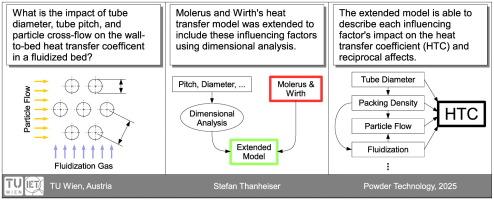Molerus and Wirth's heat transfer model for bubbling fluidized beds: Proposal for an extended model including immersed tube banks and particle cross-flow
IF 4.6
2区 工程技术
Q2 ENGINEERING, CHEMICAL
引用次数: 0
Abstract
While there are many semi-empirical correlations for estimating the wall-to-bed heat transfer coefficient in a fluidized bed, most are only usable in a limited range of operating conditions. The correlation developed by Molerus and Wirth (1997) provides the most expansive and successful model; however, it does not consider the influence of the properties of an immersed tube bank or a horizontal movement of particles (cross-flow). This study expands Molerus and Wirth's correlation to include these additional influencing factors by identifying and introducing new dimensionless factors using dimensional analysis. Collected secondary data and measurements from a test rig were used to evaluate the extended model. The model's estimates largely align with the collected secondary data and previously published models describing the influence of tube diameter and tube packing density on the wall-to-bed heat transfer coefficient. The model also provides new insight into the conditions under which a particle cross-flow contributes significantly to the wall-to-bed heat transfer coefficient. Future research should use these findings to conduct targeted measurements and further improve the model's predictions.

Molerus和Wirth的鼓泡流化床传热模型:包含沉管组和颗粒横流的扩展模型的建议
虽然有许多半经验相关性用于估计流化床壁面到床层的传热系数,但大多数仅在有限的操作条件范围内可用。Molerus和Wirth(1997)发展的相关性提供了最广泛和最成功的模型;然而,它没有考虑浸没管组的性质或颗粒的水平运动(横流)的影响。本研究通过使用量纲分析识别和引入新的无量纲因素,扩展了Molerus和Wirth的相关性,将这些额外的影响因素包括在内。从试验台收集的二次数据和测量数据用于评估扩展模型。该模型的估计在很大程度上与收集到的二次数据和先前发表的描述管径和管填料密度对壁面到床层传热系数影响的模型一致。该模型还对颗粒横流对壁面到床层传热系数有显著影响的条件提供了新的见解。未来的研究应该利用这些发现进行有针对性的测量,并进一步改进模型的预测。
本文章由计算机程序翻译,如有差异,请以英文原文为准。
求助全文
约1分钟内获得全文
求助全文
来源期刊

Powder Technology
工程技术-工程:化工
CiteScore
9.90
自引率
15.40%
发文量
1047
审稿时长
46 days
期刊介绍:
Powder Technology is an International Journal on the Science and Technology of Wet and Dry Particulate Systems. Powder Technology publishes papers on all aspects of the formation of particles and their characterisation and on the study of systems containing particulate solids. No limitation is imposed on the size of the particles, which may range from nanometre scale, as in pigments or aerosols, to that of mined or quarried materials. The following list of topics is not intended to be comprehensive, but rather to indicate typical subjects which fall within the scope of the journal's interests:
Formation and synthesis of particles by precipitation and other methods.
Modification of particles by agglomeration, coating, comminution and attrition.
Characterisation of the size, shape, surface area, pore structure and strength of particles and agglomerates (including the origins and effects of inter particle forces).
Packing, failure, flow and permeability of assemblies of particles.
Particle-particle interactions and suspension rheology.
Handling and processing operations such as slurry flow, fluidization, pneumatic conveying.
Interactions between particles and their environment, including delivery of particulate products to the body.
Applications of particle technology in production of pharmaceuticals, chemicals, foods, pigments, structural, and functional materials and in environmental and energy related matters.
For materials-oriented contributions we are looking for articles revealing the effect of particle/powder characteristics (size, morphology and composition, in that order) on material performance or functionality and, ideally, comparison to any industrial standard.
 求助内容:
求助内容: 应助结果提醒方式:
应助结果提醒方式:


